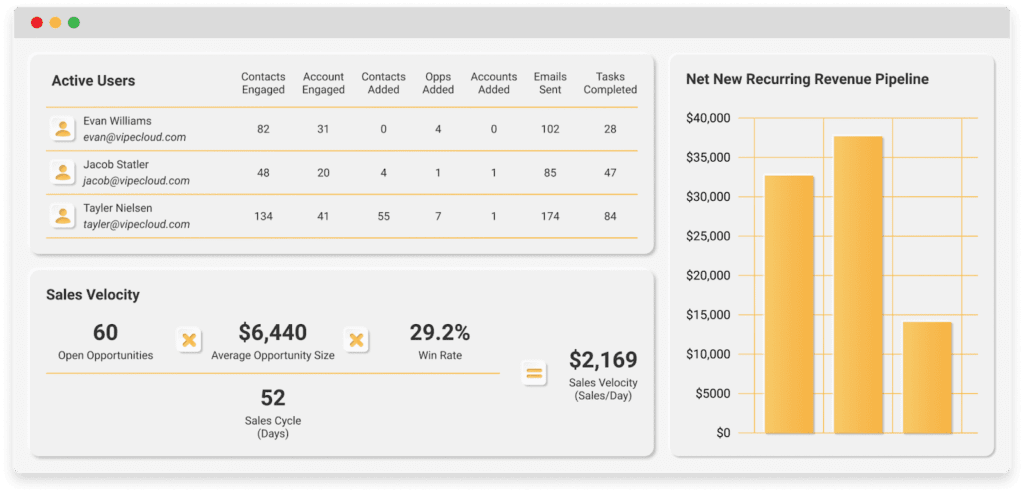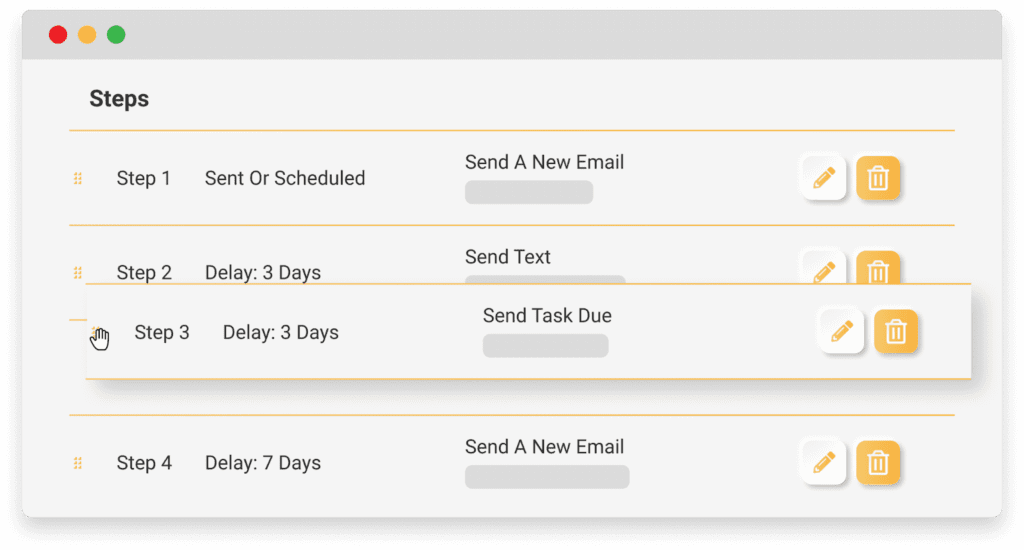Last updated on August 3rd, 2023

In this ultimate guide, you’ll learn how to close additional deals by adopting the BANT sales method and customizing it for your unique sales process.
Some leads may be cold, warm, or hot.
But you don’t truly know this until you qualify the lead.
There are numerous lead qualification techniques out there.
However, BANT has stood the test of time in being one of the best.
No, seriously:
BANT was first introduced by IBM in the 1950s and incorporates the fundamental reasons why people buy.
We’ll cover:
- What is BANT Sales?
- Why Should You Adopt BANT?
- A Breakdown of BANT Sales
- Budget
- Authority
- Need
- Timeline
- BANT Sales Script Best Practices
- How Lead Scoring Strengthens Your BANT Sales Process
- How Do You Know If Your BANT Process Is Working?
- A Final Takeaway Of BANT Sales
 Automate All Your Communications With VipeCloud
Automate All Your Communications With VipeCloud
VipeCloud is the only Automation tool your small business needs to
be the hero to your customers.
With Email, Texting, Social, Suites, Chat, Stories, Video Email & Sign Up Forms fully built-in, we provide you with the perfect platform to grow your business.
15 Day Free Trial – Get started risk free. No CC needed.
What Is BANT Sales?
BANT is an acronym that stands for:
- Budget
- Authority
- Need
- Timeline
BANT is a sales qualification framework that helps determine how qualified a lead is.
IBM and many companies have adopted it to determine a prospect’s potential value and priority.
These are four essential criteria for your sales team to base their discovery qualification questions on.
(Don’t worry, we’ll cover some good questions to ask for each category soon.)
You should know that BANT has it’s criteria in the order of most importance, starting from “Budget.”
Does this mean that the timeline isn’t all that important? No..not the case.
As a matter of fact, think of BANT like an ordered qualification checklist:
The idea is to start your sales questions around your prospect’s “budget” and work your way down.
However, not all sales convos follow a linear path like this, so other things like “need” may come first.
The big picture with BANT selling is this:
The more criteria (Budget, Authority, Need, Timeline) your lead checks off, the higher likelihood that they’re a good fit.
Here’s an example:
Say your prospect Adam is a key decision-maker in his Solar company, needs your product, and is ready to start this week.
The only issue is his budget.
With Adam satisfying 3 out of 4 criteria well, he’s a solid lead.
But this brings me to my next point:
A good prospect will have 3 criteria checked off or 2 at minimum. (And it’s ideal for the budget to be one of them.)
If they still aren’t able to move forward, like in Adam’s case, they’ll be a significant lead to follow-up with in the future!
Why Should You Adopt BANT?
BANT selling probably seems straightforward at this point, but there are a few eye-opening reasons that make it absolutely necessary.
Here’s two:
BANT Helps You Identify How & Why Someone Buys
When you’re able to segment your sales questions into these 4 magic categories, you can separate the reasons why someone is or isn’t buying.
If Prospect A has the budget, is a decision-maker, but doesn’t want to move forward — there’s a chance you haven’t conveyed the value of your product or service enough.
If Prospect B sees the value and has the budget but can’t decide yet because they have to consult with someone, you know the issue is just decision-making. (Be sure to ask follow-up questions to ensure that that’s the real reason.)
By separating why someone is or isn’t buying, your sales reps can be more effective at selling and save time on prospects that aren’t going to buy.
In one study, 721 reps were asked how much time they spend selling.
They reported spending only 35.2% of their time selling and a whopping 65% on everything else, but not selling.
With BANT, time saved can be spent doing other things like going after other pending deals.
Helps Diagnose & Overcome Objections
By knowing how and why someone buys, you can better diagnose and handle objections.
Sales reps need to be like doctors — prescribing prospects with what they need — not what you think they need.
Let’s say you know that an objection centers around value.
How do you overcome this?
You can simply prove how your product or service fixes their problem and helps them reach their goals. This can be done through statistics, case studies, or testimonials.
In this scenario, you can strictly focus on overcoming the value problem and not fixate on budget, authority, or timeline since those aren’t issues.
Sales reps should keep track of common objections they hear from each category and practice overcoming them.
It’s up to the sales rep to smash objections as much as possible so you can move the lead through your pipeline.
A Breakdown of the BANT Sales Framework
We’re now going to break down each component of BANT sales individually.
Each section will be explained — along with questions you should keep in mind.
Budget: Can Your Prospect Afford Your Product or Service?

We’ve all seen this word…
Budget is simply a prospect’s ability to afford your product or service.
The affordability of a product is a huge determining factor of whether someone will buy it or not.
Even if they like the product, it solves their problem, and your selling is A+…
No budget = no sale.
If you’re a marketing agency, bringing up the budget early helps not only qualify but gives you a chance to develop a suitable marketing plan for the prospect, based on the budget mentioned.
Here are some questions you can ask to gauge their budget:
- “Is there a budget range you have in order to fix this problem?”
- “What do you think a solution to this problem would cost?”
- “Have you previously tried fixing this problem? How much did it cost you?”
If you’re in B2B, how much your prospect’s own product or service costs along with the number of customers they service can give you a clue into their spending ability.
But don’t rely on this by itself, since everyone’s company margins are different.
Which is why asking is always best.
Authority: Who Makes the Final Decision?
“Authority” has to do with whether your lead has the executive ability to make a decision.
Keyword: “executive ability.”
Sometimes they do, sometimes they don’t, and sometimes a couple of other decision-makers have to chime in.
Speaking to a non-decision-maker can be a waste of valuable time. Here’s why:
Even if the prospect likes what you’re offering, they can’t articulate it to their higher-ups like you or your sales rep can.
Remember, no one knows your product better than you do. So getting in front of decision-makers is crucial!
The decision-making process varies from company to company, so here are a few questions to ask to help figure out how a prospect makes decisions.
- “How does your decision-making process work?” (My personal favorite. It’s not too pushy and it’s less likely to offend someone.)
- “Are you the decision-maker?” (This is the most simple one, but use it with extreme caution because it can offend prospects and make it harder to reach the decision-maker.)
- “How many decision-makers are involved?”
- “Is there anyone else that needs to vote on this?”
- “Will other decision-makers need to be on the call?”
- “Who else is involved in moving forward with our service?”
Gather All Decision-Makers
If multiple decision-makers are involved, get in contact with all of them and set a time to meet in person or on a call.
Whoever is in charge of the account should understand each decision-maker’s roles and responsibilities and do background research.
Why is this important?
It shows initiative and professionalism, which can foreshadow how you’ll be when they work with you (sharp, knowledgeable, etc.).
It also gives you vital information you can use on the call to help close the deal.
Lastly:
It’s never a bad idea to organize your sales team based on what decision-makers are around.
You can have sales reps, account managers, CEO’s and many other roles that you feel would best connect with your lead.
Need: Is the Solution Your’re Proposing Fulfilling Your Prospect’s Needs?
“Need” deals with the degree to which your product or service solves your prospect’s problem.
This is huge.
You don’t want to fling any service at a prospect just because you think it’s great.
In the marketplace, goods are sold based on value.
If the prospect doesn’t feel like they need your product, they won’t buy.
Here are some “Need” based questions your sales team can use when speaking to prospects.
- “What is this problem costing you?”
- “How much of a priority is this problem?”
- “What would happen if this problem were solved?”
- “If we solved this problem, how different would your business look in a month?”
- “What happens if you ignore this problem for another 3 months?”
Convey Value
To convey the value of what you’re selling, it needs to be clear that you have the best solution for their problem.
Value can be shown through demos, case studies, testimonials, size of your customer base, and more.
When dealing with cold leads, you’ll want to convey value early in what’s called an elevator pitch.
An elevator pitch is basically a short script of what you do, how it helps them, and a single sentence case study.
An example of an elevator pitch could be something like this:
“We help lawyers win a consistent flow of clients with SEO. Recently, we helped increase XYZ Law Group’s annual revenue by $2M in 1 year.”
What makes this a compelling pitch?
- It’s clear who you specialize in helping.
- It’s clear how you help.
- Your case study shows that you can get results.
In most cases, a case study will be your key to unlocking the trust of your prospects.
But make sure that your case study, testimonial, or other social proof is relevant to your prospect.
This can easily be done by making sure you’re using niche-specific social proof.
Timeline: What’s Your Prospect’s Purchase Timeline?
“Timeline” is your prospect’s timeframe for buying or beginning services.
Your prospect could have the budget, authority, and need. But if the time is not right, you’ll have to delay the close.
The sooner a prospect is willing to buy — the more likely they’re to close since everything is still fresh in their mind.
Sales reps should encourage prospects to get started as soon as possible without being pushy. This can be done by creating desire through asking questions like we discussed in the “Need” section.
But if a lead isn’t ready, it’s perfectly fine to follow up with them at a later time.
It’s typical for B2B to have longer sales cycles than B2C, and industry also plays a role in the cycle.
Timeline also has to do with the anticipation of future needs.
For example, let’s say you’re an ad agency. Maybe you’re speaking with a B2C eCommerce prospect that doesn’t need to run ads at the moment.
But later, during the holiday season, they’ll need your ad services because Q4 is when they make the most money.
So they have the budget, can make a decision, see the value, but the timeline is the only thing left.
Here are questions you can ask to get an idea about their timeline:
- “If this solution were to solve your problem, when would you like to start?”
- “What’s the timetable for when you’d like services to begin?”
- “Would this week/month/year be ideal for us to begin?”
- If we send an agreement/proposal, when could we expect it back signed so we can begin?
Following-up & Nurturing
If your lead’s timeline to begin is that same day or next week, then great. Send that invoice or contract!
But more often than not, you’ll have a longer timeline which will require following up — if you don’t want to lose out on the deal, that is.

44% of salespeople give up after one follow-up — but guess what?
50% of sales happen after the 5th touchpoint!
You can stay organized with longer-term leads by keeping them in a good CRM.

For example, business owners use Vipecloud’s Sales & Marketing Suite to stay on top of their warmest leads year-round.
Here are great proven ways of following up using your CRM:
- Calls
- Text messages
- Social media

Your follow-ups can include updates about your product/service, asking follow-up questions, and new periodic offers.
It’s ideal for the person that spoke with the prospect initially to be the one following up, but this isn’t set in stone.
Following up is how businesses stay top-of-mind and maintain attention.
As the old saying goes:
“Attention is currency.”
BANT Sales Script Best Practices
BANT equips sales teams to handle their leads more efficiently.
When incorporating BANT, implementing a framework into your sales “script” can come in handy.
This section will cover two best practices to help you be successful when adding BANT to your sales script.
1. Make It Light & Conversational
Let’s face it:
We know when someone’s just reading from a script.
It sounds robotic, forced, and just plain rigid.
One way of scaring off your leads is doing precisely that.
So how do you incorporate BANT naturally?
By making it as conversational as possible — this includes asking follow-up questions, and adding your own personalized statements in between.
You can have your sales team roleplay the script and improve on areas that come off “robotic.”
2. Make It Personalized
Personalization isn’t just important in your marketing, but your selling as well.
Sales scripts help sales reps stay structured during a meeting, but it will lose its punch if you’re not personalizing the script.
Here’s what I mean:
You have to incorporate your prospect’s specific problem into your script.
Just like we stated before, paint a picture of your solution solving their problem by mentioning previous customers that had the same issue they’re experiencing.
When sales reps focus less on getting to the end of the sale and more on connecting with their lead, they’ll see better close rates.
How Lead Scoring Strengthens Your BANT Sales Process
68% of marketers believe that lead scoring is one of the top revenue contributors.
Lead scoring has been an integral part of sales for many, many decades now.
It’s how prospects are ranked based on actions they take and information known about them.
It’s a fantastic way of organizing your BANT sales process because you can focus on your most important deals.
On top of that:
You can draw up customer profiles based on the best leads you’ve received.
Customer profiles are created by tracking patterns amongst qualified and non-qualified prospects.
Your company can use this information to hone in on ideal future customers.
You can score your BANT leads by assigning point values to each part of the bant framework.
Here’s an example of lead scoring in this manner:
- Budget – Score/100
- Authority – Score/50
- Need – Score/100
- Timeline Score/75
Remember, you can adjust these numbers based on what fits your organization best.
Your top prospects should have priority as far as follow-ups, which is an excellent example of sales efficiency.
From there, sales reps can work their way down to lesser qualified leads.
How Do You Know If Your BANT Process Is Working?

In business, success is recognized when you can measure your progress.
BANT is no different, so there needs to be data that shows your sales methodology is firing on all cylinders.
Using your CRM, you can check your sales reporting data to see how your conversions have changed since adopting the BANT sales methodology.
Give it at least a month of data before drawing conclusions.
If your company has a good number of sales reps, you can crunch the numbers and get an overall read of its effectiveness across the board.
Patience is key, nothing happens overnight, so compare your numbers month-to-month.
Also, get feedback from your reps and hear out how customers are responding.
- Are the conversations more upfront?
- Are customers opening up more?
- Is your sales cycle getting shorter because reps are closing faster?
Keep these in mind.
BANT vs. GPCT
What is GPCT?
GPCT is considered to be a modern version of BANT and stands for:
- Goals
- Plans
- Challenges
- Timeline
The GPCT technique appears to be more concerned with deeper knowledge and long-term solutions than with a specific need at a certain time.
You are more likely to deliver value to your potential clients if you ask them questions about their goals, plans, challenges, and, lastly, their timeframe.
Does GPCT Methodology Replace the BANT Sales Framework?
The short answer is – not really.
The BANT sales framework has lately gone out of favor since it is out of date and fails to deliver when the sales team uses it as a checklist.
Sales leads have gotten considerably wiser and more educated since the technology revolution.
This enables businesses to move quicker than ever before. Meanwhile, sales teams are finding it more difficult to exert influence over their prospects’ purchasing decision-making processes.
Focusing on how to help your prospects reach their goals increases your chances of completing the buying process.
B2B sales are difficult and time-consuming. As a result, sales managers must empower their staff by reducing sales procedures and establishing clear sales techniques that produce results.
The BANT Framework, on the other hand, enables sales teams to focus on the best prospects that may become top priorities. These leads have the proper authority, need, and timeline to acquire the product or service they are offering.
We all know that the Buyer’s Journey is a challenging journey from lead generation to closure. By providing your sales teams with tools and frameworks such as BANT and GPCT, you can ensure that they can influence the customer’s decision-making process.
A Final Takeaway On BANT Sales
BANT is a selling structure that is designed to fix sales qualification issues.
It has a long history of being adopted by top companies, and it should be customized to meet your needs.
When done right and consistently, you’ll see more deals being won, which only spells growth for your company.
In order to stay on top of your sales results and prospects, you need a specialized sales CRM like Vipecloud’s Sales Suite.
Our CRM puts you back in control of your sales system and is free for your first 15 days.
Want to see it in action? Request a demo with our team!

Leave a Reply